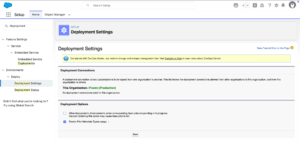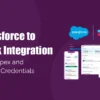What’s New for Developers in Salesforce Summer ’25 Release – Part II
Welcome Back! Here’s What’s Next in the Salesforce Summer ’25 Release for Developers
In Part 1, we explored exciting innovations around Agentforce, Apex enhancements and Data Cloud enrichments. Now in Part 2, we shift our focus to the tools that help you code faster, test smarter, and deploy cleaner—from Lightning Web Components to APIs and the latest CLI innovations.
From upgraded developer tools to extended API capabilities, and major enhancements to Lightning Web Components (LWCs), this section has everything you need to take your dev experience to the next level.
Lightning Web Components: More Flexibility, Less Friction
Preview LWCs Locally — No Org Needed (Beta)
Developers can now preview individual Lightning Web Components (LWCs) using Local Development without needing to deploy them to a Salesforce org first.
To try it out:
- Install the Local Dev plugin:
sf plugins install @salesforce/plugin-lightning-dev - Launch it with:
sf lightning dev - Use your arrow keys to pick a component — it’ll automatically open in the browser for preview.
Check out the official GitHub repository for plugin docs and examples.
Updated Lightning Base Components & Type Definitions
- Type definitions for core components are now bundled in the
@salesforce/lightning-typesnpm package. - Internal structure changes are rolling out for components like
lightning-tree-grid,lightning-user-consent-cookie, andlightning-quick-action-panelto prep for native shadow DOM — make sure your tests don’t rely on previous markup structure.
Validate SLDS Usage Automatically (Beta)
Salesforce has introduced two new ways to validate your code against SLDS guidelines:
- VS Code Extension: SLDS Validator
- Command-line Linter (Beta): Use in CI/CD pipelines
Both support automatic fixes and SLDS 2 beta rules. Check out the linter project for more.
Developer Tools & Salesforce CLI: Better, Faster, Smarter
CLI Improvements That Make Dev Life Easier
- Smarter Manifests:
project generate manifestnow includes a-excluded-metadataoption for more control. - Split External Services for Git:
ExternalServiceRegistrationmetadata can now be broken into.yamland.xmlfiles — easier for source tracking.

- Better Test Feedback: CLI now shows test durations with
-test-leveland-verboseflags. - Create Scratch Orgs from Snapshots:

- Wait for Scratch Org Resume:

Flow Testing & Automation Upgrades
You can now run Flow tests directly from the CLI, making CI/CD automation more powerful. Just use:

For even deeper insights into flow execution, check the full flow debugging updates.
AI-Powered DevOps Testing for Quality Releases
Salesforce’s DevOps Testing tool enhances DevOps Center by injecting AI into your release pipeline. After installing the add-on from AppExchange, you can:
- Add quality gates like Code Analyzer
- Integrate third-party CI tools
- Automate code quality reviews
- Learn how it works in this doc.
Salesforce Code Analyzer v5 is Now GA
Time to upgrade! Code Analyzer v5 brings next-gen static analysis with:
- Two new scan engines: Flow Scanner and Regex Detection
- AI-powered auto-fixes (Apex supported now, LWC coming soon)
- Sleek HTML reports & YAML-based configuration
- Full integration with GitHub Actions & DevOps Testing
Check out the Code Analyzer documentation for migration guidance.
API Enhancements: Smarter Metadata, OpenAPI Support & Cleaner Logins
Retrieve Metadata with Dependencies
A new rootTypesWithDependencies parameter helps you automatically pull metadata along with its dependencies. Currently supported for the Bot metadata type (useful for Agentforce).
See the implementation details in the source-deploy-retrieve package.
Try Out Pilot Metadata Types:
Want to test out new metadata types early? You can now deploy and retrieve pilot types via Metadata API — just enable the setting in your org. But remember, these may change in future releases.The screenshot below shows how to enable usage of pilot metadata types.

OpenAPI Spec for REST Resources (Beta)
Now in beta, Salesforce exposes OpenAPI 3 specs for REST resources. You can query /async/specifications/oas3 to explore available endpoints and use wildcards in URIs.
Read more in the official docs.
API Version 21.0 to 30.0 Is Being Retired
All API versions from 21.0 to 30.0 will stop working after Summer ’25. Use Event Monitoring (API Total Usage) to find outdated requests. You can also turn off these versions early via a Release Update.
Here’s a blog post with migration tools and tips.
Enforce My Domain Login URLs in API Calls
To ensure future-proof API integrations, Salesforce will start enforcing My Domain URLs in API traffic. This change goes into effect in:
- Spring ’26 (or Winter ’26 for sandboxes)
Start migrating your integrations now to avoid disruptions.
Streaming API Clients Must Handle Disconnects
In version 64.0 and up, clients may receive disconnect messages more frequently (especially on Hyperforce). Be sure to:
- Listen for
/meta/disconnect - Reconnect automatically to resume event streaming
Final Thoughts: Dev Power, Reimagined
With all the tooling, testing, and integration upgrades in this second half of the release, Salesforce Summer ’25 is shaping up to be one of the most developer-centric updates yet.
From real-time LWC previews to smarter metadata handling and AI-assisted quality gates, every feature helps you code with confidence, automate with precision, and deliver at scale.



